Will SFNs Work in North America?
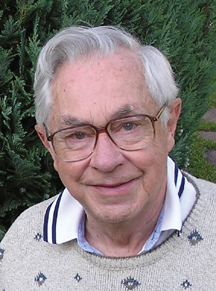
The Consumer Electronics Association (CEA) and the CTIA The Wireless Association have filed a proposal to the FCC to facilitate wireless broadband by further re-packing the broadcast spectrum, making it possible to re-allocate some broadcast spectrum to wireless broadband. In the proposal—expressly to facilitate repacking of the broadcast spectrum—they suggest that by adopting a Single Frequency Network (SFN) topology, the present minimum distances allowed between DTV transmitters operating on the same channel could be substantially reduced.
SINGLE FREQUENCY NETWORKS
An SFN is a network of lower-power transmitters distributed throughout the area to be served and synchronously radiating DTV signals on the same channel from much lower towers. This concept is not new; it is widely used in Europe. Their DTV broadcast signals are radiated by multiple transmitters to serve the community. DVB-T signals are modulated by a technique called Coded Orthogonal Frequency Domain Multiplexing (COFDM). In this scheme, nearly 8,000 carriers are equally spaced across their 8 MHz channel. Each of these carriers is digitally modulated at a very low bitrate as carriers are about 1,000 Hz apart. That means that each symbol period is 1,000 microseconds. It is well known that nearly all signal reflections (echoes) arrive at the receiver within +/–60 microseconds of the arrival of the same symbol. Multipath rejection is very effective with COFDM modulation because a small percentage of each symbol period is set aside as a "Guard Interval" by the receiver circuitry. During the first 60 µs of each symbol, DVB-T receivers "shut down" so they do not "listen" to the transmitter and so they do not "hear" echoes.
Our ATSC standard does not employ COFDM modulation so our receivers have an Adaptive Channel Equalizer to reject echoes. Early ATSC receivers did not do this too well. Great improvements have been made in the design of Adaptive Channel Equalizers. However even if all transmitters in an SFN were synchronized—as in the proposal by the CEA and CTIA—there would be co-channel interference between multiple signals on the same channel. Some may think that because the FCC has established rules governing Distributed Transmission Systems (DTS) to provide coverage in deeply shadowed neighborhoods (as behind tall buildings or hills) that SFNs would work for ATSC signals. SFN works in Europe—but for their DVB-T signals, which use COFDM. This modulation scheme was chosen because it is virtually immune to attack by multipath and multipath results from multiple transmitters on the same channel.
It is claimed that proposing the deployment of multiple low-power transmitters radiating the same program bitstream on the same channel simultaneously to replace the present single high-power transmitter and its antenna on a very tall tower would allow the same channel to operate without co-channel interference than is possible with high-power transmitters radiating from tall towers. In the west, most major population centers are very far from each other so in many cases, the same channels can be allocated to other cities. But consider the Boston to Richmond, Va. corridor. That is an excellent example of the congestion in Europe where SFNs are used and why DVB-T, their DTV standard, uses COFDM.
My concern with how DTV reception might be adversely affected by implementing SFN nationally is illustrated in a report, "Comparative Evaluation Tests on Terrestrial Digital TV Systems," by the Mackenzie Presbyterian University in Brazil and presented at the 2005 IEEE Broadcast Symposium. The data reported is for the best DTV receiver available in 2004 and the best receiver available in 2005.
SINGLE STATUS ECHO TEST RESULTS
Fig. 1 shows the threshold echo power vs. time offset for the best receivers vintage 2004 and 2005. A single static echo was tested over an offset range of from –60 µs (leading echo) to +60 µs for a trailing echo. The Desired signal was received at –50 dBm, thus receiver noise is insignificant. The blue trace (best 2004 vintage receiver) could not cope with a leading echo offset by more than 4 µs, but it did quite well for one trailing echo of +46 µs offset.
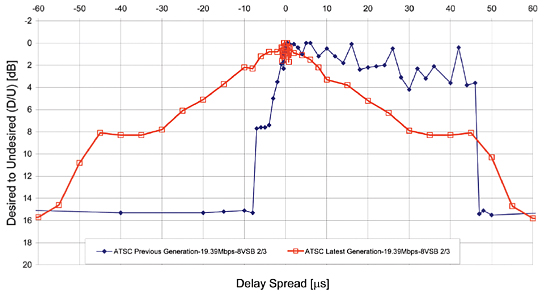
Fig. 1: Single Static Echo ATSC Fig, 2 is for the two best tested DVB-T receivers of the 2004/2005 vintage. The single static echo range was from –200 µs to +200 µs. It appears that both DVB-T receivers were designed for +/–75 µ Guard Interval. A single echo from anywhere within this Guard Interval did not disrupt reception for even the worst possible Desired to Echo power ratio of 0 dB. Such is the effectiveness of the COFDM Guard Interval.
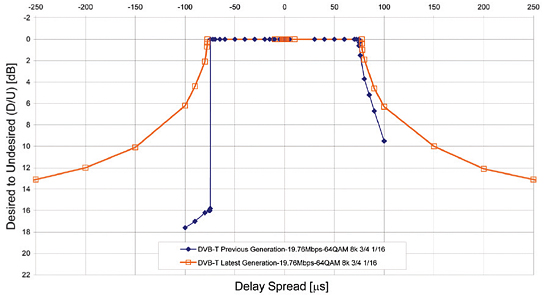
Fig. 2: Single Static Echo DVB-TSINGLE DYNAMIC ECHO TEST RESULTS
Dynamic echoes arise from echoes from a moving reflecting surface such as automobiles, or aircraft when either landing or taking off. They are classified by the change in frequency of the reflective signal vs. the direct signal. This is the well known "Doppler Effect." A Doppler shift generated by a vehicle at 60 mph is up to 120 Hz for a signal frequency of 615 MHz (channel 38) or 40 Hz for the same velocity on channel 11 (201 MHz). Aircraft taking off or landing are at 150 mph so they generate Doppler shifts 2.5 times higher than vehicles at 60 mph.
Fig. 3 compares one single dynamic echo of + 8 µs offset rejections of the best 2004 vintage ATSC receiver (blue trace) vs. the best tested 2005 receiver (red trace). My interpretation of this data is that at UHF, the best 2005 receiver would fail even with a Desired signal to echo ratio of 2 dB for nearly all Doppler Frequencies.
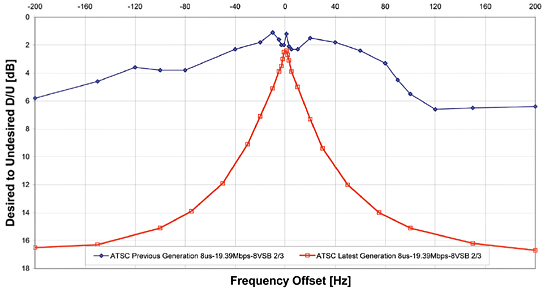
Fig. 3: Single Dynamic Echo ATSC +8 μs delay Fig. 4 shows the dynamic echo rejection for the best DVB-T receivers 2004/2005 vintage. The best tested 2005 VB-T receiver would perform at all Dopplers below +/–60 Hz under the worst case of zero dB D/E ratio. Yes, on an Autobahn in Germany you might have problems, but not in town.
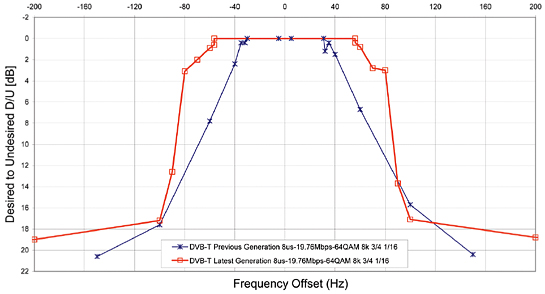
Fig. 4: Single Dynamic Echo, DVB-T. Source for all figures: "Comparative Evaluation Tests on Terrestrial Digital TV Systems," Mackenzie Presbyterian University, Sao Paulo, Brazil Our ATSC signal can be received at significantly lower signal-to-noise power ratios than can a COFDM signal supporting the same bit rate in the same bandwidth. This is because of the Guard Interval within which the signal is obscured by multipath. Furthermore, the Peak-to-Average Power ratio (PAPR) is significantly higher for COFDM than for 8-VSB modulation.
To provide the coverage required in the wide open spaces between some population centers in the United States, we need 1 megawatt average Effective Radiated Power and our PAPR is about 6 dB, so our transmitters must handle four times the average power without distortion. These differences between systems may not be too important in Europe, but they are in North America.
Some of my colleagues and I have designed and built an SFN simulator. With it, we can create up to 5 echoes, one or two can be dynamic echoes with Doppler Shift from 0.01 Hz to 600 Hz. The upper Doppler shift is 600 Hz simply because it was so easy to do it digitally. Our echo time offset is up to +/–54 µs, again simply because our simulator is all-digital, so this extended range was easy to achieve. There is no noise penalty when we increase echo offsets.
We plan to duplicate and extend the above tests with 16 NTIA-approved DTV downconverters and expand these tests to include multiple echoes and echoes of various other delays. We will test at a Desired signal of –50 dBm as did the Mackenzie Presbyterian University and at lower Desired signal levels when receiver-generated noise becomes significant.
We have arranged 16 different models of NTIA-approved DTV downconverters to receive the same set of strongest signal + echoes and we can test on locally unused channels in high VHF and the UHF bands. We will test these downconverters as surrogates for DTV receivers as we believe the same chipsets are used in these NTIA approved downconverters and in DTV receivers. Of course, given much more room than my laboratory provides, we could test DTV receivers too.
I plan to publish these results in this column late this summer and am proposing a paper on this topic for the IEEE Fall Broadcast Symposium. However we will not know if our paper is accepted by the IEEE until July. By then, we should have some interesting results.
We're conducting these tests to determine how ATSC reception would fare in various SFN configurations before the FCC begins rulemaking procedures that might involve the concept of using SFNs for terrestrial TV broadcasting in the United States. Our test data, whatever it shows, will be published in this column.
If you or your consulting engineer have thought out how a SFN might be deployed for your station in the event of re-packing, send me a map with the locations of the proposed transmitter (latitude/longitude coordinates) and the latitude/longitude of your present transmitter. Include the HAAT (height above average terrain) for each site and the ERP for each transmitter. We may try to figure out the areas of overlapping coverage where reception may be difficult even for a rooftop, directional antenna.
Editor's note: An error in the author's column in the April 7, 2010 issue, "Spectrum Repacking Looms for TV Broadcasters," concerning a proposal by the CEA and CTIA-The Wireless Association, was made during the editing process and was not made by the author.
Charlie Rhodes is a consultant in the field of television broadcast technologies and planning. He can be reached atcwr@bootit.com.
Get the TV Tech Newsletter
The professional video industry's #1 source for news, trends and product and tech information. Sign up below.
